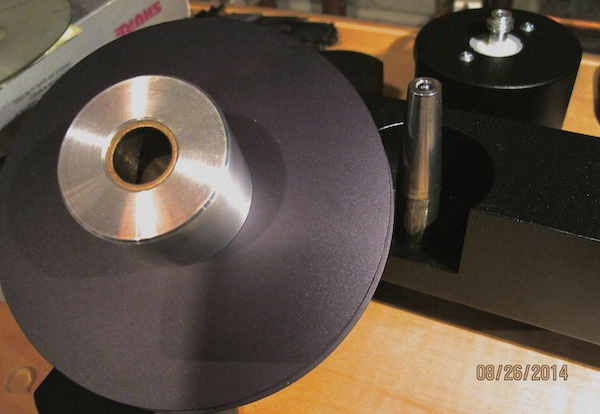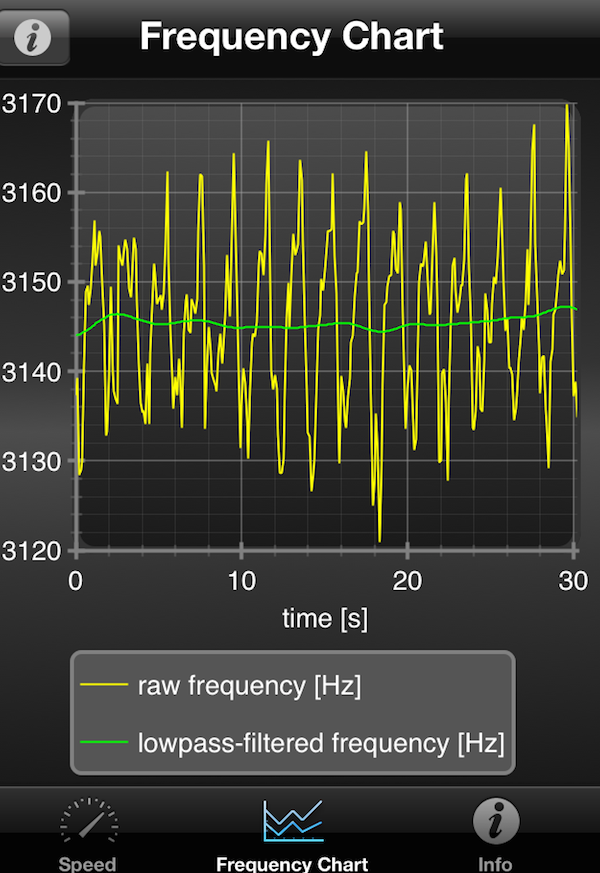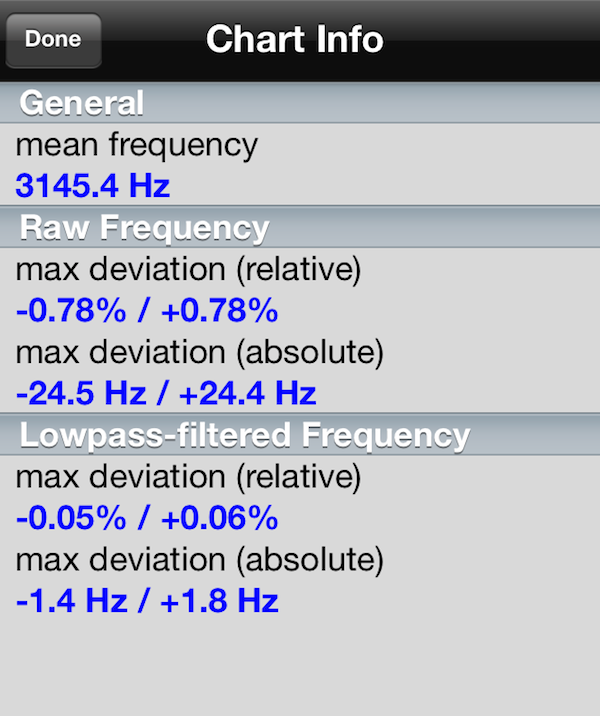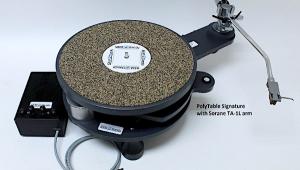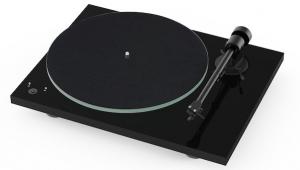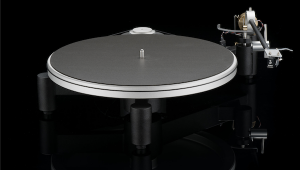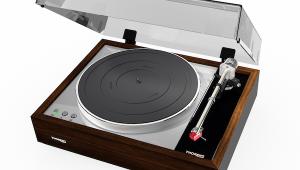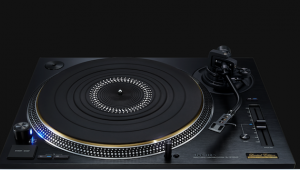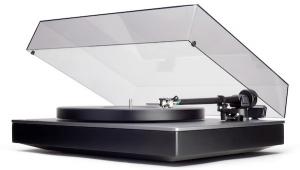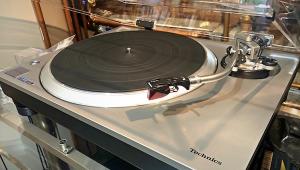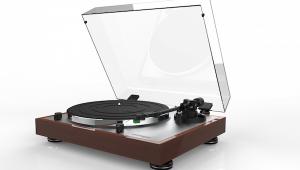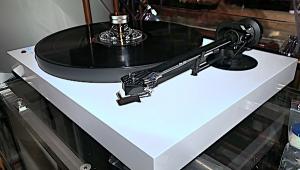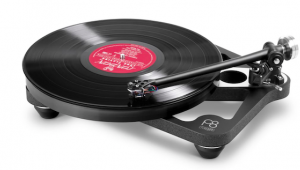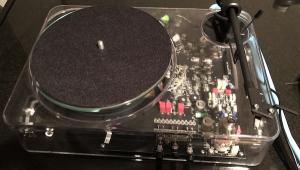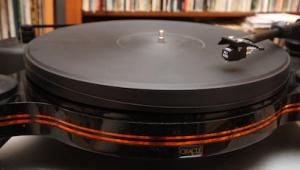AVID “T"s Off with Low Priced Ingenium Turntable
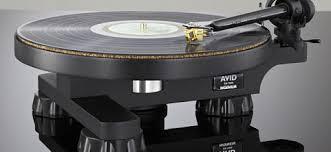
While AVID’s new Ingenium at $1999 including Pro-Ject 9cc tone arm is not “budget priced” it is but a fraction of the cost of Avid’s $37,944 flagship Acutus Reference SP turntable to which it bears scant resemblance. It more closely resembles the $4,040 Diva II but at half the price including a tone arm.
That said, a danger point for a luxury turntable manufacturer would be to issue a budget model that damages the brand, and worse, doesn’t compete sonically and mechanically with the competition.
So what has AVID done here to rein in costs? For one thing, it’s produced a skeletal, though relatively high mass “T” shaped aluminum chassis reminiscent of what Kuzma pioneered with its “brass pipe bomb”-like $2156 (w/o arm) Stabi S. We think less plinth is better than more.
Like the Diva II, the Ingenium, is an unsuspended design though with a simpler elastomer footer design. Unsuspended is my preference generally though it means the ‘table’s performance will greatly depend upon the platform upon which it’s placed. Yes, even suspended designs need a good support system but not to the same degree. The Ingenium rests upon 3 soft elastomer feet resembling an elephant’s. There’s no way to level the ‘table so the platform must be levelable.
One key to a turntable’s ultimate performance is the bearing and here’s where AVID has least compromised. It’s the identical inverted Tungsten-Carbide ball system used in the Diva II consisting of a substantial, cupped-top tapered polished stainless steel tower well-anchored within a semi-circular cut out in the main support beam, in which sits the 4mm ball. The spindle bushing—also substantial at this price point— topped inside with a sapphire thrust pad, is attached to a large diameter grooved aluminum sub-platter. The large diameter “O” ring goes around the sub-platter and the stepped A.C. synchronous motor’s pulley.
The Ingenium uses the Diva II’s lightweight, but full-sized MDF platter topped with a permanently affixed cork mat that fits over the spindle housing and rests on the sub-platter. A scew-on weight and threaded spindle is an extra cost option.
The design saves additional money with a simple in-line on-off switch placed on the A.C. cord between the wall plug and the motor housing, compared to the Diva II’s 24V A.C. motor and controller system. The arm attaches to an outcropping machined from the right side of the main “T” beam and that’s it!
Simple Set-up
The box in whch the Ingenium ships is so small you’ll think there must be another box but it’s all in there and once you’ve carefully leveled the platform, it sets up quickly, though you must have at your disposal a strobe disc. The motor’s placement is critical to achieving the correct speed (or at least as close to correct as is achievable). Too much or too little belt tension and both speed and stability suffer. So take your time with that. The review sample shipped with a Pro-Ject 9cc arm and Dynavector 10X5 cartridge aligned and ready to play.
Smooth, Rich, Airy Sound
I played for a visiting importer of very expensive gear the Ingenium fitted with the new $999 Ortofon Quintet Black MC cartridge, which is fitted with a Shibata stylus—it’s the MC equivalent of the MM 2M Black. A review will be posted shortly. The phono preamp was the intriguing current amplification Vera 20 ($2590 plus high performance power supply ($1790). He was suitably impressed and took down names and numbers.
After swapping out various known and unknown cartridges as well as various known and unknown phono preamplifiers and later using both in a known turntable, the Ingenium’s sonic character revealed itself as did its strengths and flaws.
Tonally, the Ingenium was a pleasingly smooth performer with an evenhanded balance, somewhat rich in the midrange but notably free of a mid bass bump type coloration sometimes found in ‘tables below $2500. Some ‘tables avoid the bump or a low frequency resonance produced by excess energy that the chassis is unable to absorb, by curtailing the very bottom.
This is where the Ingenium excelled, producing reasonably deep and well-defined bass, though slightly softened to go along with the overall generally soft and warm sound. The ‘table did have the advantage of being isolated in the adjacent room on a very nice Finite elemente stand sitting on a slab concrete floor but even that can’t eliminate boom and bloom from a lesser design.
The recently reviewed Analogue Productions reissue of Tony Bennett Live at Carnegie Hall didn’t produce the pin point image definition and detail, or generous soundstaging heard on the reference system but it produced a satisfying picture that led my importer-friend to exclaim “Forget about the little details Mikey, that’s music!” Which was more than he could say about another more expensive combo I played for him.
While the Bennett recording and many rock and jazz recordings indicated a turntable that will provide long-term listenability, a solo piano recording engineered all analog by AIX’s Mark Waldrep—best known for his high resolution digital recordings, not to mention his digital advocacy—pointed out the ‘table’s one significant weakness. The record, by the way (to be reviewed shortly), is Beautiful Jazz-A private concert (Wilderjazz 1401LP) by Bay area pianist Christian Jacobs. Minimally miked, recorded, mixed and mastered (by Paul Stubblebine) all analog, it’s a successful attempt to create the sensation of being in a concert hall (recorded at Zipper Hall, The Colburn School, Los Angeles, CA) seated not far from the Hamburg Steinway Model D Grand and having the pianist play just for you.
Unfortunately, the long piano note sustains point out the ‘table’s speed stability issues that are well hidden on “choppier” music. The RTI pressing too, has it’s eccentricity issues, which is unfortunate, but they are minor when played on a better ‘table and exacerbated here. The problem is, you have a light-weight platter combined with a motor plugged directly into the wall. The speed stability issue will bother some more than others mostly based upon musical tastes: no problem with rock or most jazz, definitely a problem with solo piano or classical piano with orchestra. The 3150Hz test tone was reproduced at 3145, which is close enough to correct speed to not be an issue.
Feickert Platterspeed App Chart Result
The test record’s 3150Hz fluctuating tone shown in yellow, low pass filtered to remove groove eccentricity effects in green.
Feickert Platterspeed App Numerical Result
The Speed Stability Solution
The $378 Phoenix Engineering Falcon PSU Turntable Speed Controller and $234 Tachometer arrived simultaneously with the ‘table (you can use just PSU and add later the optional Tachometer). I spent a great deal of time with the ‘table plugged into the wall before trying these units. The full review will be published shortly (there’s a great deal on Mikey’s analog plate).
Adding this $600+ option completely transformed not just the speed stability (and allowed the 'table to reproduce the 3150Hz test tone at the precisely correct speed) but the overall presentation as well. Much of the pleasing midrange fullness receded to reveal sonics much closer to more expensive ‘tables. The midrange fullness was really clouding (pleasing as it was) caused by the speed instability. On the Tony Bennett record, Bennett’s voice became far better focused and clearly defined in space, stage three-dimensionality greatly improved as did overall transparency. It was in some ways like changing the turntable. On the Jacobs record the sustain and decay became far more stable and the sea-sickness subsided to where only the slight eccentricity of the record was audible as it was on the reference ‘table. I am certain that even an inexpensive Pro-Ject Speedbox would produce an improvement but the combination of the Falcon PSU and Tachometer made a huge difference (it requires a magnet to be put on the platter side or bottom read by a Hall sensor attached to a chip that must be placed “just so” but it’s well worth it).
The Competition
At around $2000 with tone arm, the competition includes the Rega RP6 (with Exact cartridge), which sounds somewhat leaner and “faster” (and most likely runs a bit fast as most samples I’ve checked out do) and the VPI Scout 1.1, which features an MDF platter to which is bonded an aluminum plate, and an aluminum platter and A.C. synchronous motor.
There’s competition from Clearaudio, Pro-Ject and others. All of these ‘tables come with tone arms. In a perfect world I’d have them all here to compare for you but I don’t. Based upon audio recollection I’d say the Rega was the leaner faster choice, more suited for rock, though its bearing and sub-platter can’t compare to the Ingenium’s while the VPI’s bearing is comparable to the Ingenium’s but its heavy aluminum platter is many significant notches better than the Ingenium’s of MDF. While all of these individual attributes can be compared, in the end the turntable’s components perform as a system and often the whole is far greater than the sum of its parts.
Conclusion
Taken as an out-of-the-box product, the Ingenium is a nicely built, easy to set up and use turntable with a substantial minimalist aluminum chassis, an outstanding bearing system—probably the best in its class—and a lightweight MDF platter that helps produce less than excellent speed stability coupled with an ungoverned A.C. synchronous motor. Still at half the price of the Diva II, AVID has packed the Ingenium with a great deal of performance and quality engineering.
Sonically the Ingenium defines the word “musicality” and provides for long term listening pleasure with its shortcomings, other than the speed issue on instruments with long sustains, well-hidden. Were I to buy the Ingenium with Pro-Ject 9cc arm, I’d definitely add a speed controller and a moderate mass record weight. While the Falcon PSU and Tachometer “tach” on almost 30% to the total price, in my opinion the addition more than doubles the Ingenium’s sonic performance.
As delivered for $1999 with arm the Ingenium is still an attractive combination that incorporates an outstanding bearing system and an upgrade path that can greatly improve performance. AVID has managed to produce an excellent turntable at half the price of its previous lowest cost turntable. Add a motor controller, even the relatively pricey but sophisticated Falcon, and you are still below $3000 with tone arm. That’s impressive.
